
The Wii is a home video game console developed and marketed by Nintendo. It was released on November 19, 2006, in North America and in December 2006 for most other regions of the world. It is Nintendo's fifth major home game console, following the GameCube and is a seventh-generation console alongside Microsoft's Xbox 360 and Sony's PlayStation 3.
The Virtual Console is a line of downloadable video games for Nintendo's Wii and Wii U home video game consoles and the Nintendo 3DS family of systems.
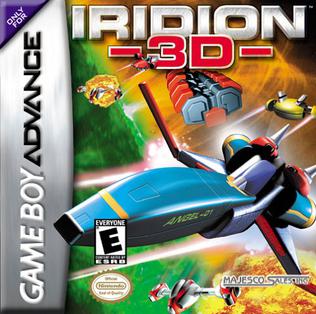
Iridion 3D is a quasi-3D rail shooter video game developed by Shin'en Multimedia. A launch title for the Game Boy Advance portable game console, it was released in North America on June 11, 2001 and in Europe on September 21. The player controls a single starship defending Earth from the alien Iridion. The game spans seven levels from Earth to the aliens' home planet, each following a linear path that culminate with a boss.

The Classic Controller is a game controller produced by Nintendo for the Wii home video game console. While it later featured some compatibility with the Wii U console, the controller was ultimately succeeded by the Wii U Pro Controller. In April 2014, Nintendo discontinued production of both the Classic Controller and Classic Controller Pro.
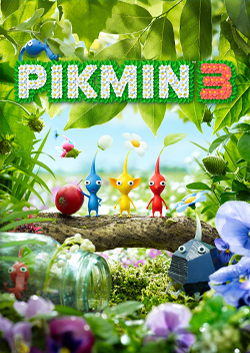
Pikmin 3 is a 2013 real-time strategy and puzzle video game developed and published by Nintendo for the Wii U video game console. It is the sequel to the GameCube games Pikmin (2001) and Pikmin 2 (2004), and was released in Japan on July 13, 2013, and in all other regions the next month. Shigeru Miyamoto announced Pikmin 3 on July 16, 2008, for the Wii console, later stating at E3 2011 that it had transitioned to the Wii U.

The GameCube controller is the standard game controller for the GameCube home video game console, manufactured by Nintendo and launched in 2001. As the successor to the Nintendo 64 controller, it is the progression of Nintendo's controller design in numerous ways. The contentious M-shaped design of its predecessor was replaced with a more conventional handlebar style controller shape; a second analog stick was added, replacing the C buttons with a C stick and the X and Y face buttons, last seen on the Super Nintendo controller, were reintroduced; the shoulder buttons were changed to hybrid analog triggers. A wireless variant of the GameCube controller known as the WaveBird was released in 2002.
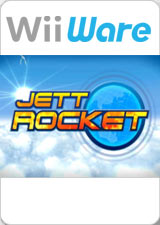
Jett Rocket is a platform video game developed by Shin'en Multimedia for the Wii's WiiWare service. It was released on June 28, 2010 in North America and in Europe on July 2, 2010 for 1000 Nintendo Points. On November 24, 2010, a demo of Jett Rocket was made available for free on the Wii Shop Channel.
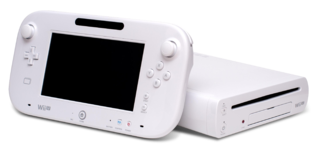
The Wii U is a home video game console developed by Nintendo as the successor to the Wii. Released in late 2012, it is the first eighth-generation video game console and competed with Microsoft's Xbox One and Sony's PlayStation 4.

Mario & Sonic at the London 2012 Olympic Games is a 2011 crossover sports and party game developed by Sega Japan. It was published by Nintendo in Japan and Korea and by Sega elsewhere. As the third instalment in the Mario & Sonic series, it was released on the Wii on 15 November 2011 in North America, 18 November 2011 in Europe, and 26 December 2011 in Japan. It was also released for the Nintendo 3DS in February 2012. Mario & Sonic is the official video game of the 2012 Summer Olympics and is licensed by the International Olympic Committee through exclusive licensee International Sports Multimedia. The game is the only Wii title to come in a yellow keep case.
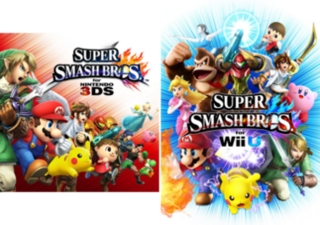
Super Smash Bros. for Nintendo 3DS and Super Smash Bros. for Wii U are 2014 crossover platform fighter video games developed by Bandai Namco Studios and Sora Ltd. and published by Nintendo for the Nintendo 3DS and Wii U video game consoles. It is the fourth installment in the Super Smash Bros. series, succeeding Super Smash Bros. Brawl. The Nintendo 3DS version was released in Japan on September 13, 2014, and in North America, Europe, and Australia the following month. The Wii U version was released in North America, Europe, and Australia in November 2014 and in Japan the following month.

New Super Mario Bros. U is a platform video game developed and published by Nintendo. It was originally released in 2012 as a launch game for the Wii U. It is the fourth and final entry in the New Super Mario Bros. series, and is the first Super Mario game to be released in high-definition graphics. The game is a sequel to New Super Mario Bros. Wii (2009) and a follow-up to New Super Mario Bros. 2 (2012).

The Wii U GamePad is the standard game controller for Nintendo's Wii U home video game console. Incorporating features from tablet computers, the GamePad has traditional input methods, touchscreen controls, and motion controls. The touchscreen can be used to supplement a game by providing alternate, second screen functionality or an asymmetric view of a scenario in a game. The screen can also be used to play a game strictly on the GamePad screen without the use of a television display. Conversely, non-gaming functions can be assigned to it as well, such as using it as a television remote.

Nintendo Land is a party video game developed and published by Nintendo as a pack-in launch title for the Wii U home video game console in 2012. The game was first announced at E3 2012 during Nintendo's press conference.

Off-TV Play is a feature of Nintendo's eighth-generation video game console, the Wii U. Like all video game consoles, the Wii U uses a console and a controller to manipulate an image on a television screen. The Wii U's unique feature is that its controller, the Wii U GamePad, has its own built-in screen for displaying images. It can display an entirely different image, or duplicate the television screen into the Wii U GamePad. Off-TV Play is the term used for when an entire game is played strictly on the controller, without the use of a television. The GamePad also features two speakers that can be used for Off-TV Play. There is no standardized way to activate Off-TV Play and how it's implemented depends on the game.

Mario Kart 8 is a 2014 kart racing game developed and published by Nintendo for the Wii U. It retains the gameplay of previous games in the Mario Kart series, with players controlling a Mario franchise character in races around tracks. Tracks are themed around locales from the Super Mario platform series and are populated with power-ups that help players gain advantages in races. Different difficulties are selectable prior to a race; harder difficulties make gameplay faster. In the new anti-gravity sequences, players drive on walls and ceilings. Mario Kart 8 contains a variety of single-player and local and online multiplayer games modes, including Grand Prix racing and arena-based battle modes.

Fast Racing Neo is a futuristic racing video game developed by Shin'en Multimedia and released worldwide for the Wii U in December 2015 via the Nintendo eShop, with a retail release in September 2016 in Europe and Australia only. It is the second entry in the Fast series, being the sequel to Fast Racing League. It is often compared to Nintendo's F-Zero franchise.
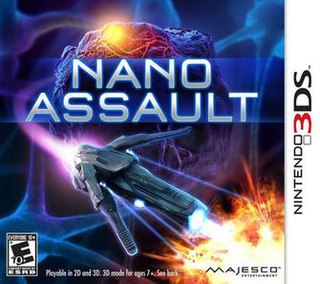
Nano Assault is a shoot 'em up video game developed by Shin'en Multimedia for the Nintendo 3DS, originally published as a retail title by Majesco Entertainment in 2011, while the Japanese version was published by CyberFront on 19 April 2012. It is the spiritual successor to the Nintendo DS games Nanostray and Nanostray 2.

Fast Racing League is a racing game developed and published by German video game developer Shin'en Multimedia and released for Wii as a WiiWare title on 27 May 2011. It is the first installment in the Fast series.
Fast is a series of racing video games developed by German game developer Shin'en Multimedia. Released exclusively for Nintendo platforms, the series consists of three games, all following the same racing and phase-shifting formula, Fast Racing League, Fast Racing Neo, and Fast RMX.

















